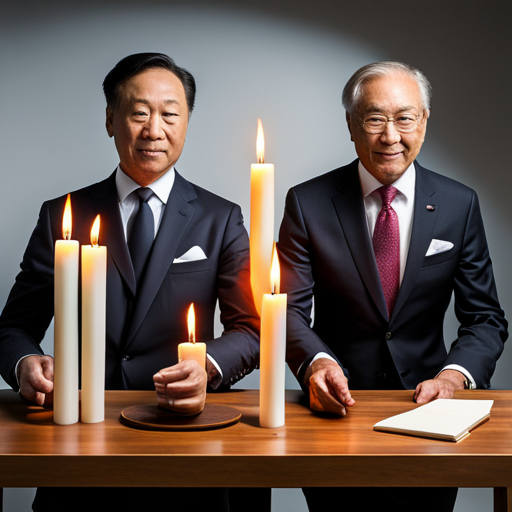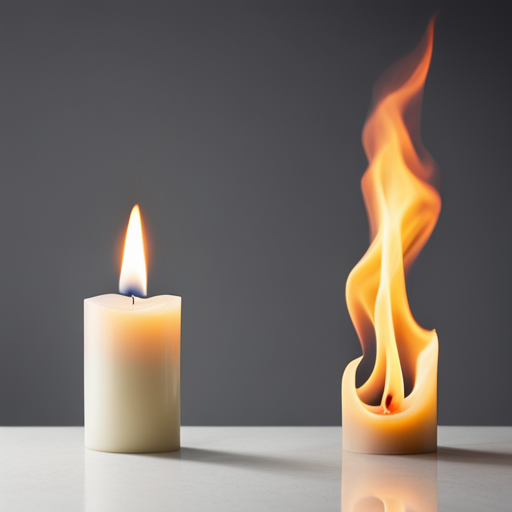By understanding these variables, readers can make informed choices when selecting candles that provide both fragrance and a longer-lasting burn. So, let’s delve into the world of scented candles and uncover the truth behind their burn speed.
Key Takeaways
– Scented candles made with paraffin wax burn up to 30-50% faster than beeswax candles and soy quality candle types.
– Natural wax with fragrance burns slower, so scented candles made with soy wax may burn longer than unscented ones.
– The size of the candle container and the wick in the candle also affect burn time.
– Proper candle care, such as trimming the wick and burning for periods no longer than 3 hours, can extend burn time.
Factors Affecting Burn Time of Scented Candles

https://www.youtube.com/watch?v=RkbfBR7aDSM
The melting points of different candle waxes, such as paraffin wax and soy wax, can affect the burn time of scented candles. Scented candles made with paraffin wax have a higher melting point compared to those made with soy wax. This means that paraffin wax candles tend to burn faster than soy wax candles.
The burn time of a scented candle is also influenced by the type of wax used. For example, beeswax candles have a longer burn time compared to paraffin wax candles.
Additionally, the size of the candle container and the wick used can also affect burn time. A larger wick burns faster, while a smaller wick burns slower but may result in tunnelling.
Overall, the choice of wax and other factors can impact the burn time of scented candles.
Comparison of Wax Types and Burn Rates

Paraffin wax has a faster melting point compared to other wax types, affecting the burn rate of scented candles. This means that scented candles made with paraffin wax tend to burn faster than those made with beeswax or soy wax.
The higher melting point of paraffin wax allows the candle to release its fragrance more quickly, resulting in a shorter burn time. On the other hand, candles made with soy or beeswax, which have lower melting points, burn at a slower rate, allowing the scent to be released more gradually.
Therefore, if you prefer a longer-lasting scented candle, it is advisable to choose one made with soy or beeswax. However, it is important to note that other factors, such as the size of the candle container and the wick used, can also affect the burn time of scented candles.
The Impact of Candle Size and Wick on Burn Time

Opting for larger candle containers and using a larger wick can result in faster burn times. When the candle container is bigger, more wax is present, leading to a larger pool of melted wax. This allows for a larger flame and faster burning.
Similarly, using a larger wick provides more fuel for the flame, causing it to burn more quickly. However, it is important to note that faster burn times may result in a shorter overall lifespan of the candle. Additionally, using a larger wick can lead to a higher risk of soot and smoke.
Therefore, it is crucial to find the right balance between burn time and candle longevity to ensure a pleasant and safe candle-burning experience.
Candle Care Tips for Longer-Lasting Burn

Using proper candle care techniques, such as trimming the wick and limiting burn time, can help extend the burn duration of scented candles. Trimming the wick to about 1/4 inch before each use ensures a clean and efficient burn. This prevents the wick from becoming too long and causing the candle to burn faster.
Additionally, it is important to limit the burn time of scented candles to no more than 3 hours at a time. This allows the wax to melt evenly and prevents the candle from overheating, which can result in a shorter burn time.
Exploring the Relationship Between Scent and Burn Speed

The relationship between fragrance and burn speed is worth exploring to understand how different scents can impact the duration of a scented candle’s burn. The table below highlights the burn times of various scented candles made with different wax types:
| Wax Type | Burn Time (in hours) |
|---|---|
| Paraffin Wax | 4-6 |
| Beeswax | 6-8 |
| Soy Wax | 8-10 |
| Coconut Wax | 10-12 |
As the table shows, scented candles made with coconut wax tend to have the longest burn time, while those made with paraffin wax have the shortest. This suggests that the type of wax used, along with the fragrance, plays a significant role in determining burn speed. However, it is important to note that other factors such as wick size and candle container size also influence burn time. By considering all these factors, candle enthusiasts can make informed choices when selecting scented candles for their desired burn duration.
The Role of Paraffin Wax in Faster Burn Times

Paraffin wax, commonly used in scented candles, contributes to faster burn times. This type of wax has a higher melting point compared to other candle waxes, such as soy or beeswax. As a result, the heat from the flame quickly melts the paraffin wax, causing the candle to burn more rapidly. This can result in scented candles made with paraffin wax burning up to 30-50% faster than candles made with other wax types.
However, it is important to note that the burn time of scented candles can also be affected by factors such as the size of the candle container, the wick used, and the care taken in burning the candle. By understanding these factors, candle enthusiasts can make informed choices to maximize the burn time of their scented candles.
The Potential Benefits of Soy Wax for Extended Burn Time

Soy wax, an alternative to paraffin wax, offers potential benefits for achieving an extended burn time in scented candles. Compared to paraffin wax candles, which have a higher melting point, soy wax has a lower melting point, allowing it to burn slower and last longer. This makes it an ideal choice for those looking for candles that can provide a longer-lasting fragrance experience.
Additionally, soy wax is known for its clean-burning properties, which means it produces less soot and smoke compared to paraffin wax. This not only contributes to a healthier indoor environment but also helps to maintain the quality and longevity of the candle.
Overall, using soy wax in scented candles can be a great option for those wanting to enjoy a prolonged burn time and a cleaner, more eco-friendly candle experience.
Understanding the Influence of Container Size on Burn Rate

In the previous subtopic, the potential benefits of soy wax for extended burn time were discussed. Now, let’s shift our focus to understanding the influence of container size on burn rate.
– The size of the candle container plays a significant role in determining how long a scented candle will burn.
– Smaller candle containers tend to burn faster, resulting in a shorter burn time.
– On the other hand, larger candle containers can accommodate more wax, allowing for a longer burn time.
This information highlights the importance of considering the container size when purchasing scented candles. Whether you prefer a longer-lasting burn or a quicker burst of fragrance, the size of the container should be taken into account.
Debunking Myths: Does Scent Affect Burn Speed?

The scent of a candle has no significant impact on how quickly it burns. Many people believe that scented candles burn faster than unscented ones, but this is actually a myth.
The burn time of a candle is primarily determined by factors such as the type of wax used and the size of the candle container. Scented candles made with paraffin wax may have a faster burn time compared to unscented ones, but this is due to the properties of the wax rather than the scent itself.
In fact, scented candles made with natural wax, such as soy or beeswax, can actually have a longer burn time than unscented ones. So, if you enjoy the aroma of scented candles, there is no need to worry about them burning faster than unscented ones.
Does the presence of a scent affect the burning time of a candle?
Yes, the scent’s impact on candle burning is significant. Scented candles tend to burn slightly faster than unscented ones due to the added fragrance oils. The presence of a scent can affect the composition of the wax, wick, and flame, ultimately influencing the burning time of the candle.
Frequently Asked Questions
What Are Some Common Candle Care Tips to Extend Burn Time?
Some common candle care tips to extend burn time include trimming the wick, burning for no longer than 3 hours, and using proper candle containers. These practices can result in slower burn times and longer-lasting candles.
How Does the Size of a Candle Container Affect Burn Time?
The size of a candle container affects burn time. Larger containers with 12 ounces can burn for eight hours, while smaller ones burn for around seven hours. Proper candle care can also extend burn time.
Are There Any Benefits to Using Soy Wax for Longer Burn Times?
Using soy wax in scented candles can result in longer burn times compared to other wax types. The natural fragrances in soy wax burn slower, making the candles last longer.
Can the Type of Wax Used in Scented Candles Affect Burn Speed?
The type of wax used in scented candles can affect burn speed. Scented candles made with paraffin wax generally burn faster due to its higher melting point. Opting for soy wax candles may result in longer burn times.
Is There Any Evidence to Support the Claim That Scented Candles Burn Faster Than Unscented Ones?
There is no certain evidence that scented candles burn faster than unscented ones. Opting for soy wax candles with natural fragrances can result in longer burn times, as soy wax has a lower melting point.

